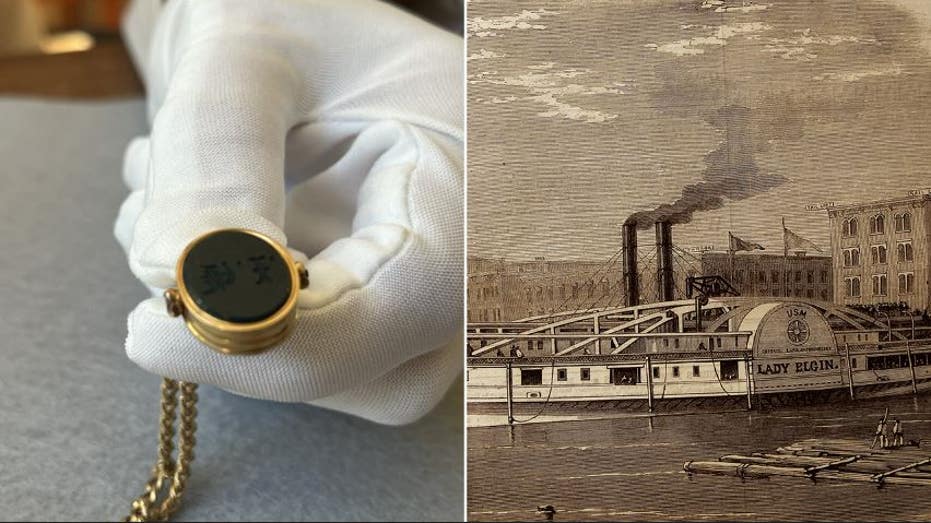In an extraordinary turn of events, a historic gold watch that had been lost for over a century and a half in Lake Michigan has finally made its way back home. This remarkable discovery not only sheds light on a tragic maritime incident but also renews interest in the stories that the lake’s depths hold.
The watch was retrieved from the site of a shipwreck that occurred in 1858, when the steamer ‘Lady Elgin’ met a catastrophic fate. The ship sank after colliding with another vessel and subsequently capsized, resulting in the loss of over 300 passengers and crew members, making it one of the most disastrous maritime accidents in U.S. history.
For many years, the tragic tale of the Lady Elgin remained buried beneath the surface, both literally and figuratively. The wreck, located off the shore of Highland Park, Illinois, not only claimed lives but also the possessions of those on board, including the gold watch that has now resurfaced. This watch, a family heirloom belonging to one of the ship’s passengers, represents a piece of history that was thought to be lost forever.
After years of exploration and underwater research, a team of marine archaeologists ventured into the depths of Lake Michigan. Their mission: to uncover artifacts from the Lady Elgin wreck site. Little did they know that they would unearth the gold watch, which had been resting silently on the lake bed.
The find was made possible thanks to advancements in underwater exploration technology. With the help of remotely operated vehicles and sonar imaging, the team successfully located and retrieved several items of historical significance, including the watch. The watch, crafted in the mid-1800s, is a stunning example of the craftsmanship of the era, adorned with intricate engravings and elaborate timekeeping mechanisms.
Following its recovery, the watch underwent a thorough cleaning and restoration process to preserve its condition and integrity. Experts carefully examined the piece and reported that it still bears the initials of its original owner, identifying it as belonging to a prominent figure from that era. This identification process not only adds a personal touch to the artifact but also connects present generations with their ancestors. It serves as a tangible link to the past, illustrating the lives and stories of those who traveled on the ill-fated Lady Elgin.
In recent weeks, the gold watch has become a focal point in discussions surrounding maritime history, the powerful stories of resilience and tragedy that shape our understanding of the ages gone by. It has been presented at local museums and events, educating the public about the Lady Elgin disaster and the importance of preserving our nation’s maritime heritage.
The tale of the Lady Elgin shipwreck is one shrouded in tragedy, but this recent discovery also symbolizes hope and connectivity. The gold watch has sparked renewed interest in the shipwreck, prompting ongoing research into the lives of those aboard and the circumstances of that fateful night. Historians and maritime enthusiasts are now encouraged to investigate further into similar maritime events throughout history, potentially leading to the discovery of more lost artifacts.
This situation illustrates the delicate relationship between humans and the natural environment, particularly in water bodies like Lake Michigan, which is known for its unpredictable weather and treacherous conditions. The Lady Elgin’s sinking serves as a reminder of the perils faced by early 19th-century travelers and the ongoing mystery of what lies in the depths of our waters.
The emergence of the gold watch also raises pertinent questions regarding how artifacts from shipwrecks should be handled. As maritime archaeologists delve deeper into recovering lost treasures, they ponder the best practices for preserving and displaying such artifacts responsibly while respecting the memories of those who were lost. The recovery of the watch has ignited a conversation about the ethical implications of salvaging items linked to tragic events.
As we reflect on the Lady Elgin’s story, it’s crucial to recognize not just the object itself but the human stories connected to it. The watch is not merely a beautiful timepiece; it was once a cherished belonging, a part of someone’s daily life. It represents dreams, journeys, and the reality of loss, capturing the essence of a bygone era.
Currently, plans are underway to showcase the restored gold watch in a special exhibition dedicated to the Lady Elgin at a local history museum. The exhibition aims to engage visitors with interactive displays and educational programs centered on maritime history, the significance of shipwrecks, and the ongoing quest to understand the past through preserved artifacts. Museum officials hope that this will inspire future generations to take an interest in preserving and protecting their local history.
This re-emergence of the gold watch symbolizes not just the retrieval of a lost item but the reclaiming of a narrative that has long been submerged. It serves as a testament to the dedication of historians, archaeologists, and those passionate about uncovering and commemorating history. As more artifacts are discovered, they shed light on the realities of life and death at sea, each piece telling its own story of bravery, tragedy, and the intricate stories of humanity.
As we look to the future, the gold watch’s return from the depths of Lake Michigan is more than just a remarkable archaeological feat; it signifies the importance of knowing our history and the tales of those who came before us. Such discoveries not only inform our understanding of past events but also connect us more profoundly to our present and future as we continue to navigate the waters of time.
Indeed, as generations pass, these lost treasures serve as reminders that every artifact carries with it an echo of the lives once intertwined with it. The return of the gold watch from the Lady Elgin symbolizes a bridge to the past, urging society to listen and learn from the voices of history that have washed ashore once more.
































